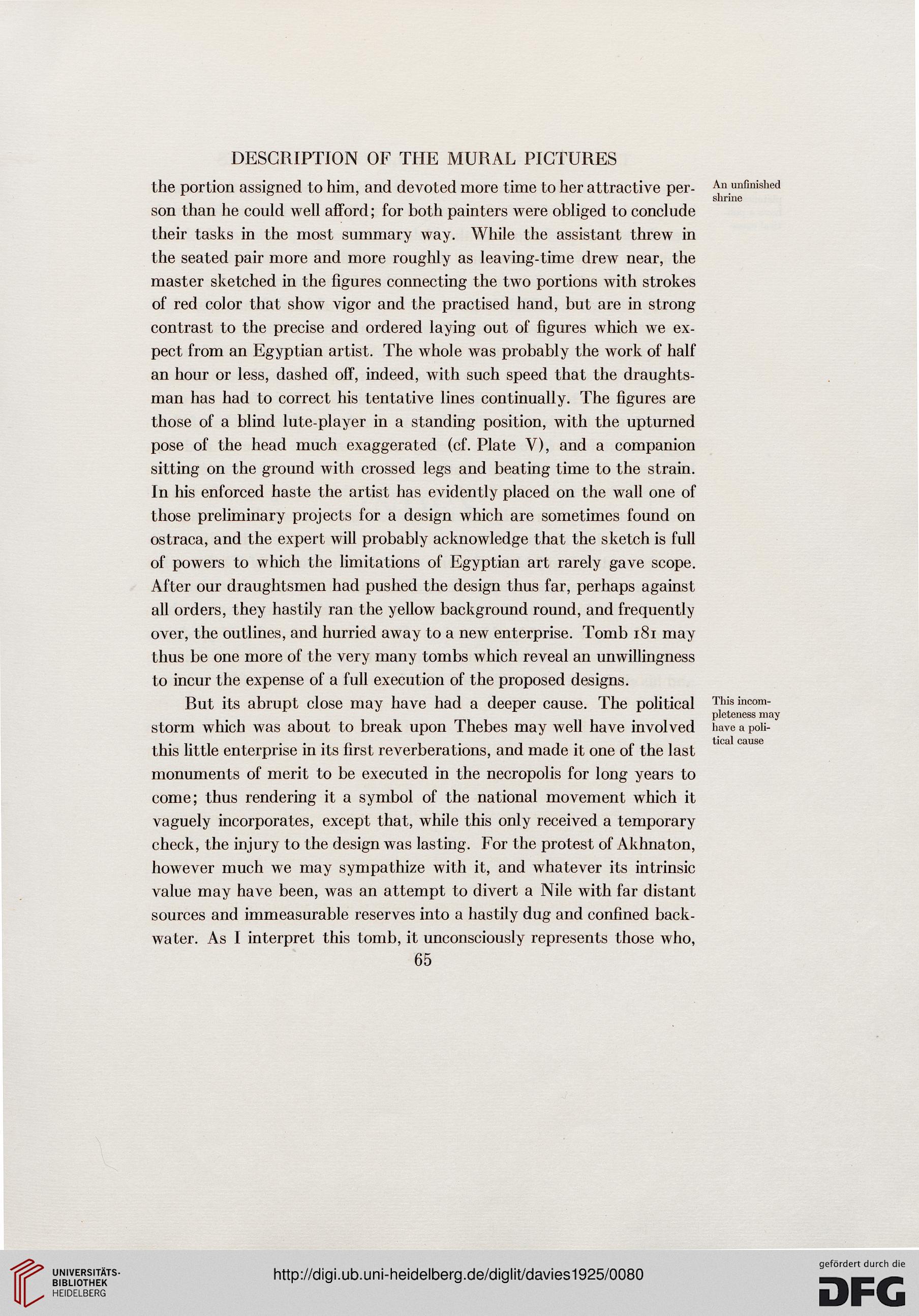DESCRIPTION OF THE MURAL PICTURES
the portion assigned to him, and devoted more time to her attractive per-
son than he could well afford; for both painters were obliged to conclude
their tasks in the most summary way. While the assistant threw in
the seated pair more and more roughly as leaving-time drew near, the
master sketched in the figures connecting the two portions with strokes
of red color that show vigor and the practised hand, but are in strong
contrast to the precise and ordered laying out of figures which we ex-
pect from an Egyptian artist. The whole was probably the work of half
an hour or less, dashed off, indeed, with such speed that the draughts-
man has had to correct his tentative lines continually. The figures are
those of a blind lute-player in a standing position, with the upturned
pose of the head much exaggerated (cf. Plate V), and a companion
sitting on the ground with crossed legs and beating time to the strain.
In his enforced haste the artist has evidently placed on the wall one of
those preliminary projects for a design which are sometimes found on
ostraca, and the expert will probably acknowledge that the sketch is full
of powers to which the limitations of Egyptian art rarely gave scope.
After our draughtsmen had pushed the design thus far, perhaps against
all orders, they hastily ran the yellow background round, and frequently
over, the outlines, and hurried away to a new enterprise. Tomb 181 may
thus be one more of the very many tombs which reveal an unwillingness
to incur the expense of a full execution of the proposed designs.
Rut its abrupt close may have had a deeper cause. The political
storm which was about to break upon Thebes may well have involved
this little enterprise in its first reverberations, and made it one of the last
monuments of merit to be executed in the necropolis for long years to
come; thus rendering it a symbol of the national movement which it
vaguely incorporates, except that, while this only received a temporary
check, the injury to the design was lasting. For the protest of Akhnaton,
however much we may sympathize with it, and whatever its intrinsic
value may have been, was an attempt to divert a Nile with far distant
sources and immeasurable reserves into a hastily dug and confined back-
water. As I interpret this tomb, it unconsciously represents those who,
65
An unfinished
shrine
This incom-
pleteness may
have a poli-
tical cause
the portion assigned to him, and devoted more time to her attractive per-
son than he could well afford; for both painters were obliged to conclude
their tasks in the most summary way. While the assistant threw in
the seated pair more and more roughly as leaving-time drew near, the
master sketched in the figures connecting the two portions with strokes
of red color that show vigor and the practised hand, but are in strong
contrast to the precise and ordered laying out of figures which we ex-
pect from an Egyptian artist. The whole was probably the work of half
an hour or less, dashed off, indeed, with such speed that the draughts-
man has had to correct his tentative lines continually. The figures are
those of a blind lute-player in a standing position, with the upturned
pose of the head much exaggerated (cf. Plate V), and a companion
sitting on the ground with crossed legs and beating time to the strain.
In his enforced haste the artist has evidently placed on the wall one of
those preliminary projects for a design which are sometimes found on
ostraca, and the expert will probably acknowledge that the sketch is full
of powers to which the limitations of Egyptian art rarely gave scope.
After our draughtsmen had pushed the design thus far, perhaps against
all orders, they hastily ran the yellow background round, and frequently
over, the outlines, and hurried away to a new enterprise. Tomb 181 may
thus be one more of the very many tombs which reveal an unwillingness
to incur the expense of a full execution of the proposed designs.
Rut its abrupt close may have had a deeper cause. The political
storm which was about to break upon Thebes may well have involved
this little enterprise in its first reverberations, and made it one of the last
monuments of merit to be executed in the necropolis for long years to
come; thus rendering it a symbol of the national movement which it
vaguely incorporates, except that, while this only received a temporary
check, the injury to the design was lasting. For the protest of Akhnaton,
however much we may sympathize with it, and whatever its intrinsic
value may have been, was an attempt to divert a Nile with far distant
sources and immeasurable reserves into a hastily dug and confined back-
water. As I interpret this tomb, it unconsciously represents those who,
65
An unfinished
shrine
This incom-
pleteness may
have a poli-
tical cause




